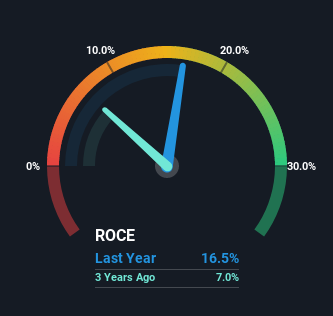
There are a few key trends to look for if we want to identify the next multi-bagger. One common approach is to try and find a company with returns on capital employed (ROCE) that are increasing, in conjunction with a growing amount of capital employed. Put simply, these types of businesses are compounding machines, meaning they are continually reinvesting their earnings at ever-higher rates of return. However, after briefly looking over the numbers, we don't think Costain Group (LON:COST) has the makings of a multi-bagger going forward, but let's have a look at why that may be.
Understanding Return On Capital Employed (ROCE)
For those who don't know, ROCE is a measure of a company's yearly pre-tax profit (its return), relative to the capital employed in the business. The formula for this calculation on Costain Group is:
Return on Capital Employed = Earnings Before Interest and Tax (EBIT) ÷ (Total Assets - Current Liabilities)
0.16 = UK£38m ÷ (UK£482m - UK£251m) (Based on the trailing twelve months to December 2022).
Therefore, Costain Group has an ROCE of 16%. In absolute terms, that's a satisfactory return, but compared to the Construction industry average of 9.5% it's much better.
Check out our latest analysis for Costain Group

Above you can see how the current ROCE for Costain Group compares to its prior returns on capital, but there's only so much you can tell from the past. If you'd like to see what analysts are forecasting going forward, you should check out our free report for Costain Group.
What Does the ROCE Trend For Costain Group Tell Us?
There hasn't been much to report for Costain Group's returns and its level of capital employed because both metrics have been steady for the past five years. Businesses with these traits tend to be mature and steady operations because they're past the growth phase. With that in mind, unless investment picks up again in the future, we wouldn't expect Costain Group to be a multi-bagger going forward. With fewer investment opportunities, it makes sense that Costain Group has been paying out a decent 30% of its earnings to shareholders. Given the business isn't reinvesting in itself, it makes sense to distribute a portion of earnings among shareholders.
One more thing to note, even though ROCE has remained relatively flat over the last five years, the reduction in current liabilities to 52% of total assets, is good to see from a business owner's perspective. Effectively suppliers now fund less of the business, which can lower some elements of risk. We'd like to see this trend continue though because as it stands today, thats still a pretty high level.
What We Can Learn From Costain Group's ROCE
We can conclude that in regards to Costain Group's returns on capital employed and the trends, there isn't much change to report on. It seems that investors have little hope of these trends getting any better and that may have partly contributed to the stock collapsing 88% in the last five years. In any case, the stock doesn't have these traits of a multi-bagger discussed above, so if that's what you're looking for, we think you'd have more luck elsewhere.
If you'd like to know about the risks facing Costain Group, we've discovered 1 warning sign that you should be aware of.
While Costain Group may not currently earn the highest returns, we've compiled a list of companies that currently earn more than 25% return on equity. Check out this free list here.
New: AI Stock Screener & Alerts
Our new AI Stock Screener scans the market every day to uncover opportunities.
• Dividend Powerhouses (3%+ Yield)
• Undervalued Small Caps with Insider Buying
• High growth Tech and AI Companies
Or build your own from over 50 metrics.
Have feedback on this article? Concerned about the content? Get in touch with us directly. Alternatively, email editorial-team (at) simplywallst.com.
This article by Simply Wall St is general in nature. We provide commentary based on historical data and analyst forecasts only using an unbiased methodology and our articles are not intended to be financial advice. It does not constitute a recommendation to buy or sell any stock, and does not take account of your objectives, or your financial situation. We aim to bring you long-term focused analysis driven by fundamental data. Note that our analysis may not factor in the latest price-sensitive company announcements or qualitative material. Simply Wall St has no position in any stocks mentioned.
About LSE:COST
Costain Group
Provides smart infrastructure solutions for the transportation, energy, water, and defense markets in the United Kingdom.
Flawless balance sheet and undervalued.

